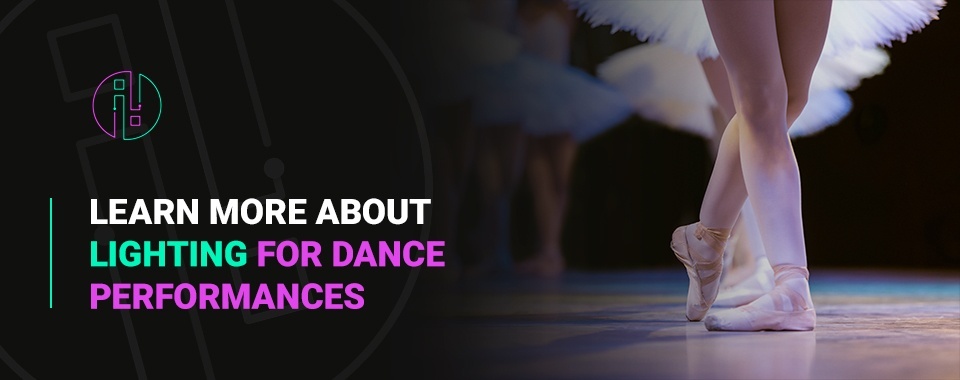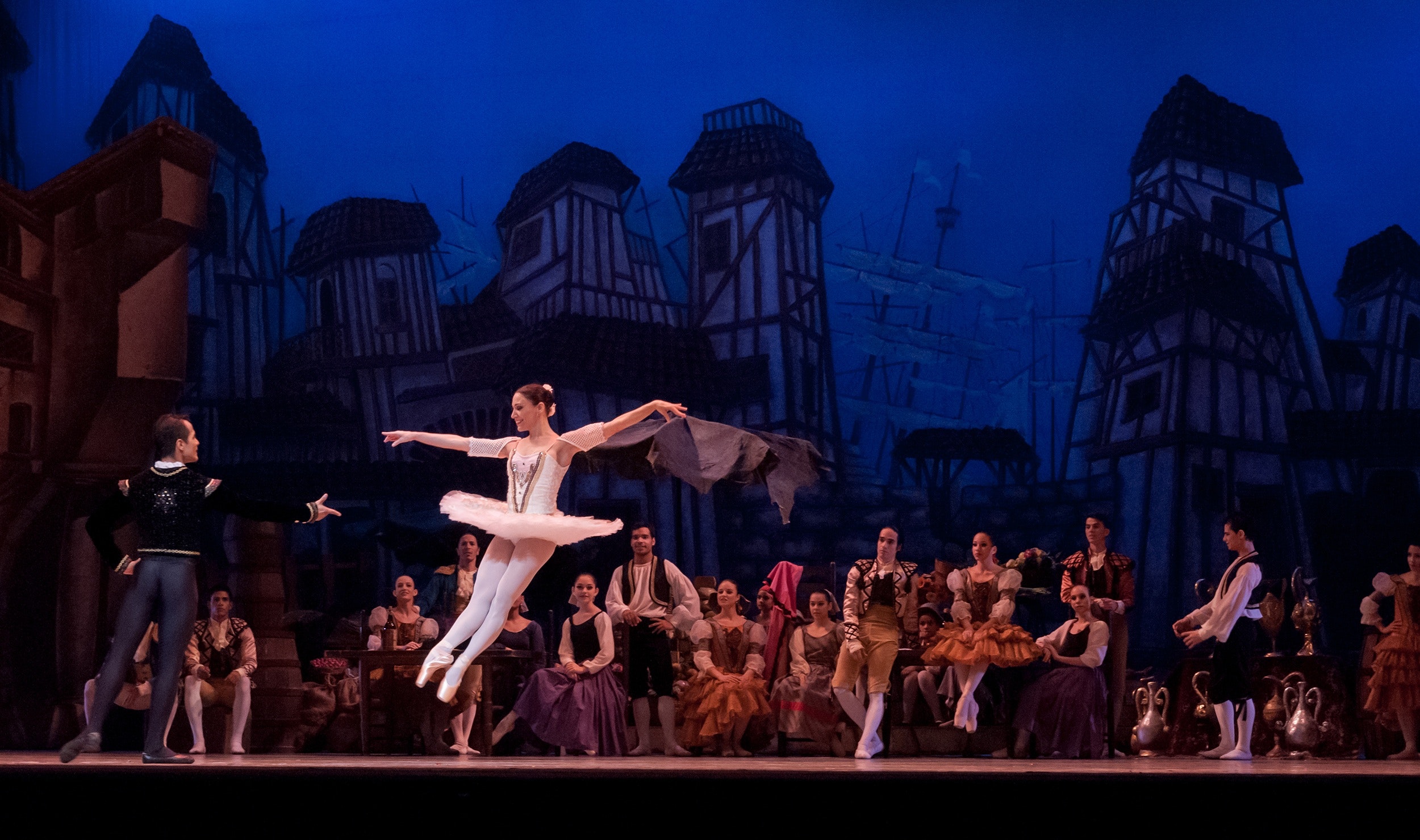

When dancers perform on stage, they bring the theater to life with a dynamic, athletic art form. Dance is an expression of moving bodies and all the patterns, shapes and stories they show. Effective stage lighting contributes to that art-making, highlighting movements at the right moments and framing each dance piece so the audience receives a complete theatrical experience.
Stage position lighting for dance performances highlights the action on stage while letting the dancers see their surroundings. As a lighting designer, you have the pivotal job of helping performers dance their best while providing the ambiance for a spectacular show.
With communication and industry knowledge, you can expertly illuminate all kinds of performances, from lighting for dance studios to concepts for professional companies. Here are some tips to help you plan lighting designs and staying on track during production schedules.
Stage lighting directs the audience’s eyes to all the action happening on stage. Dance pieces often include large casts, and with so many people moving around, lighting can focus viewers’ attention on critical aspects. You can layer a wash light for the entire stage with more prominent lighting accents, so the whole stage is visible, but emotional moments still command focus.
Dance pieces can also consist of solos and duets, where only one or two people are on stage at a time. Lighting can emphasize this intimacy by spotlighting one area of the stage while the rest stays dark.
Using ambient light is another way to set the scene, particularly if the performance is more subtle than showy. Or, for a silhouette or halo effect, backlighting produces striking imagery, particularly when combined with choreography that emphasizes the moving body’s potential for making unique shapes and angles.
When designing a lighting concept for a dance performance, communicate with the choreographers. The people who created the dance pieces you’re illuminating will often have specific visions for how they want their work to look on stage. Understanding the intentions behind each section of movement will help you know what to highlight so you can create designs that best align with their desires.
If possible, begin collaborating with the choreographers early in the production process, so you can take your time deciding the ideal positioning of lighting equipment for the entire performance. Designing a lighting plot helps you synthesize many lighting schemes into one fixed equipment setup that can accommodate several colors, textures and intensities. Ask choreographers and artistic directors if they’d like any specific lighting aspects, such as highlighting a particular section of the stage at a critical point in the performance.
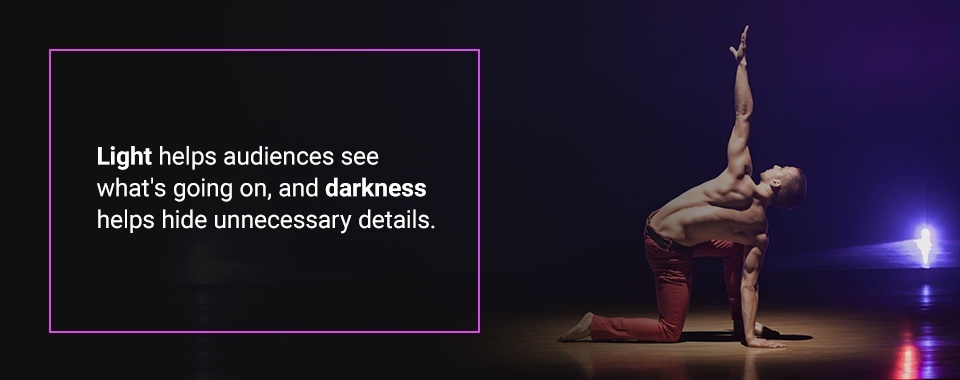
Dance lighting conveys vital information to the dancers and the audience, such as when to pay attention and what to notice. Depending on the type of performance and the resources you have available, you may darken the stage after each section of a performance and re-illuminate it with a different scheme once dancers come on stage again. Or, for a more seamless transition between scenes in the same story, you could cross-fade by bringing in new lighting as you slowly dim the previous lighting.
Light helps audiences see what’s going on, and darkness helps hide unnecessary details. You can illuminate one area of the stage while keeping others dark to mask dancer entrances or exits that could distract from the main events on stage. Lighting also conceals the stage’s ordinary floor, walls and curtains to focus on the dancers and transport audiences through an atmospheric experience.
Paying attention to the dance pieces themselves will help you familiarize yourself with the choreography’s pacing, timing and dynamic shifts. Just as dancers take cues from each other’s movements, you can study their work to understand when they could benefit from changes in lighting or spotlights on specific moments. If the dance pieces you’re illuminating have music, you can also determine some musical cues that will let you know when to transition to the next step in your lighting scheme.
Dance is an artistic and expressive device. Even dance pieces without a definite story or plot still aim to convey emotions for their audiences. Many aspects can contribute to a piece’s specific mood, including the dancers’ body language, movements, interactions and facial expressions, plus the music they dance to.
Lighting can also play a role in helping audiences understand a piece’s intentions. Dim lights can make the stage appear dark and dismal, while bright ones produce a more cheerful atmosphere. Warm glows evoke comfort, while cold, stark lights can create a harsh and even clinical environment.
Changing the lighting from scene to scene is an effective way to show shifts in mood. If one dance piece is happy and the next is somber, different lighting concepts can reveal this change for the audience, even before the dancing begins. Or, in full-story performances, lighting changes can heighten dramatic tension or indicate when a main character is on stage.
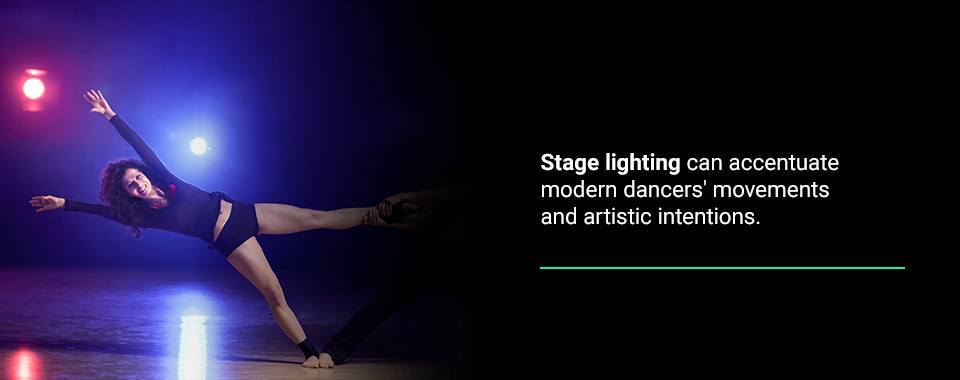
Dance as an art form embraces several different styles, each with specific characteristics, inspirations and focuses that make them uniquely captivating. You can spotlight this variety by learning what’s critical to each genre and creating lighting schemes that reflect those artistic goals. Here are some of the many dance styles you may see on stage.
As dance styles and choreography constantly evolve, genres are increasingly blending or rejecting conventional classifications to form new ways of moving and performing. For instance, contemporary ballet combines many traditional ballet steps with the weighted, free movements of styles like modern. Postmodern dance subverts various traditions and requires lighting concepts that are as innovative as the movements themselves. Choreographers who combine styles or blaze new trails might want their lighting concepts to reflect the unique stories they’re telling.
Often, dance performances that tell a story include backdrops or props that help audiences understand what’s going on in the absence of spoken words. If you’re designing a lighting concept for a performance that includes these additional features, you’ll want to make sure the audience can clearly see these contextual components.
When a stage uses a white backdrop curtain, you can even use lights to comprise the backdrop itself. If the dance piece evokes a scene on a sunny day, help transport audiences to that place with a blue backdrop streaked with white to represent clouds. If the performance is part of a winter concert, projecting snowflakes in the background can complete the image.
In many cases, dance pieces will be more abstract and won’t have many indications of setting, leaving it up to you and the choreographer to decide what kind of backdrop to create.
Dance and color have a long shared history. As practitioners of a largely nonverbal art form, concert dancers have long used colors in their costumes and performance settings to help convey specific emotions and reinforce or subvert storytelling tropes.
When considering what color lights to use for a dance performance, first familiarize yourself with the dancers and their costumes so you can choose colors that will complement their skin tones and clothing instead of washing them out. Also, collaborate with the choreographers and costume designers so you can all decide on a unified visual approach.
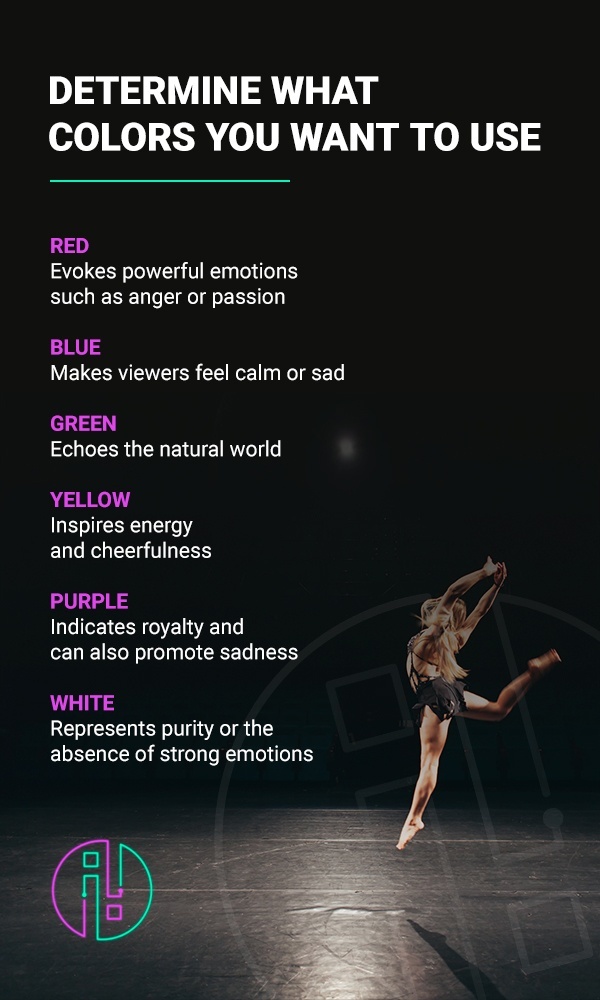
Colors have different meanings based on the ways they commonly make people feel. Some of the most popular interpretations of colors you may use in dance lighting concepts include the following.
In addition, you can use color temperature, which is the level of white light saturation, to emphasize what your color choices represent for the specific piece you’re lighting. Lower color temperatures have less white, so they look warm and soft, while higher color temperatures have more white, often used to achieve a cold, clear atmosphere.
Tech rehearsals are a collaboration among a dance performance’s cast and crew, where everyone performs trial runs of the choreography and stage technology to help ensure smooth sailing on opening night. These rehearsals are your chance to put your lighting plot into action and finalize your plans based on how everything looks on stage.
Keep in mind that in many situations, tech rehearsals will mark the first time dance casts rehearse on the actual performance stage. Their other rehearsal spaces may be bigger or smaller than the stage area or use a different type of floor. During the first few runs of each piece, dancers may still be figuring out how to fill this new space and safely execute their movements with more or less friction than they’re used to.
Stage lighting can be a boon to dancers in this transitional time, giving them cues for when to enter and exit and where to position themselves on stage during their performances.
Since lighting for dance studios and lighting for performance spaces often differ, allow time for dancers to adjust to the lighting concepts you’ve created for them. Be aware that you may need to change your initial lighting plan once you see it in action. Write down any changes, so your crew has a guide to follow during performances.
During tech rehearsals, you’ll also need to collaborate with the sound and stage crew to determine an order of events. Will there be a curtain to open? If so, will it open before or after the music begins? Will the music start before the lights go up, or after? Rehearsals are your opportunity to work with everyone at once and define a solid plan of action.
As the dance performance approaches, make sure your lighting technicians have everything they need to stick to your design plans. Between shows, assess how your lighting plans panned out, and remember to set everything up correctly to restart the performance from the beginning.
Even with lots of preparation, technical difficulties may still arise. Modern theaters’ sensory experiences rely on the proper operation of technology such as soundboards, speakers and, of course, many different lights and their controls.
If a mishap throws off your carefully planned lighting scheme, do your best to alleviate it in the moment. Then, when the performance is over, take more time to figure out what happened and how you can fix or work around the issue.
Dance performances rely on many hardworking people, all aiming for a successful run. Your ability to work with others and adjust to real-time events is part of the magic of live performance.
Lighting a dance performance involves much more than helping audiences see. Dance lighting is an intimate collaboration among color, emotion and the moving body. When you design a lighting concept, you contribute to the art unfolding onstage.
Here at Illuminated Integration, we know each performance is unique. That’s why we work with you in collaborative design consultations to create a one-of-a-kind lighting concept to suit your exact needs. From small auditoriums to large theaters, we think creatively to design and implement all the best technology, unifying audio, visual and lighting systems for coherent performances of all kinds.
If you have questions about performance lighting design or would like to learn more about our menu of services, contact us today!
